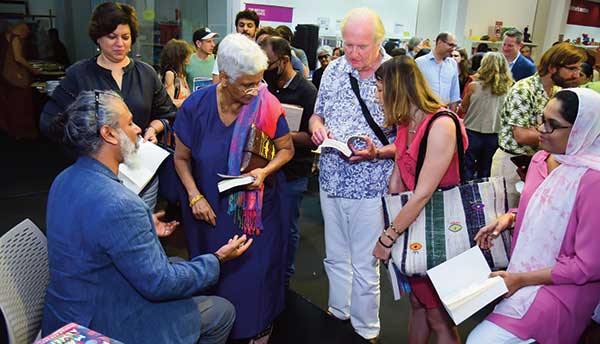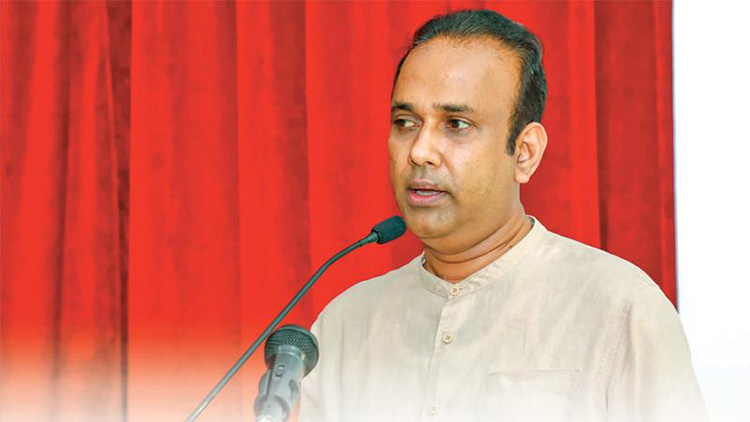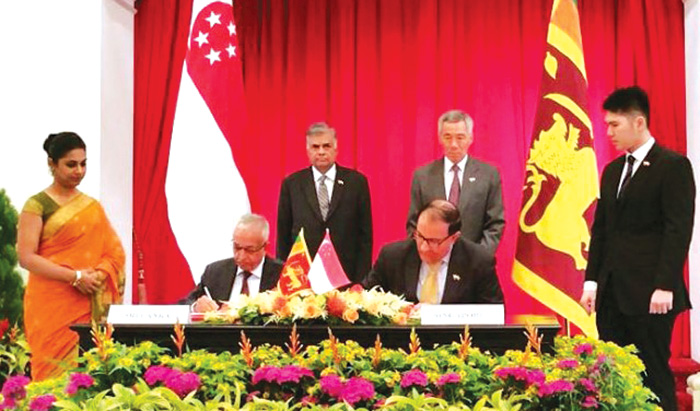Features
Two brilliant writers – Booker Prize winners

Salman Rushdie (age 75) is back on the world literary stage and welcomed strongly by other novelists and writers in general. His new book, handed over to his publisher – Random House – in December 2021 is to be released on February 7. He was not physically present at the many seminars and meetings held to herald his book and pay tribute; he is blinded in one eye and still recovering from the stabbing on stage in the Chatutauqua Institute in New York on August 12, 2022, just before he was due to address his audience. The assailant, 24 year old Hadi Matar, was arrested at the scene but has pleaded not guilty to charges of assault and attempted murder.
Random House – in December 2021 is to be released on February 7. He was not physically present at the many seminars and meetings held to herald his book and pay tribute; he is blinded in one eye and still recovering from the stabbing on stage in the Chatutauqua Institute in New York on August 12, 2022, just before he was due to address his audience. The assailant, 24 year old Hadi Matar, was arrested at the scene but has pleaded not guilty to charges of assault and attempted murder.
The government of Iran denied knowing about the stabbing though state media celebrated it. Never to be forgotten is the fatwa declared by the then Iranian Supreme Leader Ayatollah Ruhollah Khomeini with a promised bounty of $3 million for Rushdie’s death soon after he published The Satanic Verses in 1988. Die hard Muslims thought it blasphemous of Prophet Mohammed. Rushdie went into hiding in Britain, protected by British security forces for almost a decade. He then shifted to New York. He was knighted in 2007.
The 2022 attack shocked the world and shook writers. He had been revered as a free speech icon and in spite of the fatwa (rescinded in 1998) he continued to write and speak against intolerance. After the grievous attack last summer, fellow writers and cultural figures expressed outrage and gathered for vigils in his honor, sharing personal stories about him and reading from his novels. One of these I read about was on the steps of the New York Library with Kiran Desai joining many others. Chief Executive of PEN America, Suzanne Nossal commented: “They failed to silence him.”
New Book
Titled Victory City, Rushdie’s recent novel is about a gifted storyteller and poet named Pampa Kampana who creates a new civilization through her imagination. Blessed by a goddess, she lives nearly 240 years, long enough to witness the rise and fall of her empire in southern India – Vijayanagar – which translates to Victory City. Her lasting legacy is an epic poem. She writes a message at the end of her epic which she buries in a pot as a message for future generations: “All that remains is this city of words. Words are the only victors.” So true for the present and particularly in the author’s case where he was nearly killed twice; his books are read and re-read and his new book eagerly awaited and commented on, even pre-publication.
One comment: “Framed as the text of a rediscovered medieval Sanskrit epic, Victory City is about myth making, story-telling and the enduring power of language.” Novelist Colum McCann writes: “He is saying something quite profound in Victory City. He’s saying ‘you will never take the fundamental act of storytelling away from people’. In the face of danger, even in the face of death, he manages to say that storytelling is one currency we all have.”
Margaret Atwood at a panel discussion on the novel said she felt an obligation to speak about Rushdie’s latest work, given that he was not able to appear publicly himself, as reported by Alexandra Alter and Elizabeth A Harris in the January 25 New York Times. “You have to, as it were, foil the attempt to shut him down. He’s been through so much, being in hiding for all those years, feeling under threat.” The article I quote from is titled: Victory City in which a gifted story teller and poet created a new civilization through the sheer power of her imagination. The two reviewers indicate that in the novel Rushdie seems to be saying: “I will use this mighty weapon of language which is stronger than anything you can throw at me.” They also comment on his nature – funny, quick-witted, extraordinarily resilient. “It is hoped Victory City would shift attention back to Rushdie’s fiction – a novelist more than free speech advocate or a victim of malicious assault.” They classify Victory City as a joyful, oversize romp of a book, an extravagant book wherein his full creative capabilities are shown. “He is a story teller and novelist more than a political symbol.”
I admit Rushdie is not easy to read. I attempted many times to get into Midnight’s Children (1981) but failed until I saw the Deepa Mehta directed 2012 film which clearly depicted the plot of two infant boys being exchanged in a maternity ward by a nurse on malicious instructions given her on the night of Partition when Pakistan was created and India gained independence from the British Raj. The boys are from a rich Hindu mother and Muslim roadside singer. Their fortunes are traced magically through terrible vicissitudes against the backdrop of Hindu- Muslim racial tensions and rich against poor. This, Rushdie’s second novel, shot him to fame and won him the Booker Prize.

Then came the fateful Satanic Verses with its satirical depictions of Prophet Muhammad in 1988. The Moor’s Last Sigh followed in 1995 “which traced the downward spiral of expectations experienced by India as post-independence hopes for democracy crumbled during the emergency rule declared by PM Indira Gandhi in 1975.” Fury was out in 2001, after the author’s move to the US. It traces a doll maker’s arrival in New York leaving his wife and child in London. A Times reviewer said “Although Rushdie inhabits his novels in all manner of guises and transformations, he had never been so literally present as in this one.” His one but the last novel Joseph Anton (2012) is a memoir narrating his experiences after the fatwa was issued. The title is the name Rushdie assumed while in hiding, a combination of the names of two of his favourite authors: Joseph Conrad and Anton Chekov. It gives glimpses of his childhood – an alcoholic father and Rushdie’s s marriages. He has been much married! Clarissa Luard 1976-87; Marrianne Wiggins 1888-93; Elizabeth West 1999-2004 and Padma Lakshmi – Latin American actress, model and TV host from 2004 to 2007; having met her in 1999.
Now, with the release of Victory City, writers are again rallying around Rushdie to champion his work. Many see it as a moment to celebrate Rushdie’s exuberant and playful imagination, to turn attention back to his fiction. Some say the book’s “overarching message — that stories will outlast political clashes, wars, the collapse of empires and civilizations” — has taken on a heightened resonance in light of what Rushdie has endured.
One cannot help but mourn the deaths of our own writers who championed honesty and free speech. No closure to most of those instigated assassinations. Lasantha Wickrematunge’s in particular.
Chat with Shehan Karunatilaka Ashok Ferrey
asked a couple of questions from Shehan Karunatilaka and commented on his work with the venue –library of the British Council in Kollupitiya – filled to capacity by invitees and guests who paid for admission.
It is opportune that I write about Salman Rushdie and Shehan K in the same article as they are both Booker Prize winners and thus equal in honour and consideration as novelists. India boasts ten Booker short listed of whom six were winners: V S Naipaul, Salman Rushdie, Arundathi Roy, Kiran Desai, Arvind Adigar and Gitanjali Shree who won the International Booker awarded to a non-English and translated novel. Tiny Sri Lanka boasts three short listed – Anuk Arulpragasam in 2021; and two of them who won the coveted, very competitive prize: Shehan K and Michael Ondaatji. Ondaataji is Canadian but makes it a point to add Sri Lanka to his country origin.
The entire conversation was absorbingly interesting and made light and easy by the two on stage. Shehan noted that plot is easy in novel writing; it is style, voice, choice of language and building up characters that needed concentration and working on. He condensed 40 years of civil war and the turmoil of the late 1980s which was really the tip of the iceberg. A criticism, mentioned by Ashok, that the Seven Moons of Maali Almeida conveys a rather ugly picture of the country and its people, and shows Sri Lanka in a very negative light, had Shehan reply with a chuckle that he was not writing a touristy novel, far from it. He said tourism would not be adversely affected by his descriptions; and for history, his book should not be read. However, his fiction is heavily coloured by fact. He mentioned here the success of the film series The Crown which he watched avidly. He said the protagonist Maali Almeida was not at all him, not even completely Richard de Zoysa on whom he based his character. Maali was a photographer and gambler which Richard was not.
He chose to write about ghosts and the underworld since it was a niche not written much about. He did much research, spoke to people and of course edited heavily as the novel was first published as Chats with the Dead but was revised heavily. He acknowledged the debt he owed Natalia Jansz who suggested improvements and changes, and her husband Mark Ellingham who published his book. He magnanimously said that much of the honour of winning was due to her painstaking and scrupulous editing. For example as suggested by her, he spent much time defining the four minor characters in the book – the van driver and garbage collector included.
He admitted to having a sixth sense in his proven-to-be-successful choice of subject and plot. One was choice of a ‘ghost story’ and in the earlier novel – cricket. He was surprised that though Sri Lankans are crazy about cricket, no novel centered the game.Hence his plot and character development in Chinaman: The Legend of Pradeep Mathew, which won him awards and international fame.
Black humour was hugely present in his novel, pointed Ashok. Shehan admitted it was deliberate, specially its lack of lightness as writing about the dead and where they go to is black. He added that humour and enjoyment of fun are Sri Lankan characteristics.
He added “I enjoy writing. Research is good. Plotting, character building and rewriting consequent to suggested edits is painstaking. When you start writing you don’t think about sales, targets etc. But you have in mind the imperative that you write a book that appeals, more especially when it’s a novel. “
A personal note here. I found it, like others, difficult to go through Shehan’s book easily. That is a deficit of mine. Seven Moons… is truly multifaceted carrying significance and symbolism, so it is a great book. After all it won the world’s most prestigious literary prize in English, now having to compete with vast numbers of American writers. It and Rushdie’s Midnight’s Children are on par. Our own Shehan Karunatilake is up there among the world’s greatest literary fiction writers in the English language. We appreciatively thank him for bringing honour to this country; and to Ashok Ferrey – Gratiaen Prize winner for 2022 – for making the evening of literary appreciation at the British Council a super event.
Again I end with the thought that haunts many a Sri Lankan, the planned merciless killing of Richard de Zoysa just because, it is surmised, he wrote a play parodying a sentence used to characterize the leader of then. And also of Rajini Thiranagama, mercilessly shot from behind by a Tamil Tiger. These are just two innocents who lost their lives at the whim of the Lankan govt heads, LTTE and JVP terrorists. But the comfort is that their written words lives on. They must never be forgotten.
Features
The heart-friendly health minister

by Dr Gotabhya Ranasinghe
Senior Consultant Cardiologist
National Hospital Sri Lanka
When we sought a meeting with Hon Dr. Ramesh Pathirana, Minister of Health, he graciously cleared his busy schedule to accommodate us. Renowned for his attentive listening and deep understanding, Minister Pathirana is dedicated to advancing the health sector. His openness and transparency exemplify the qualities of an exemplary politician and minister.
Dr. Palitha Mahipala, the current Health Secretary, demonstrates both commendable enthusiasm and unwavering support. This combination of attributes makes him a highly compatible colleague for the esteemed Minister of Health.
Our discussion centered on a project that has been in the works for the past 30 years, one that no other minister had managed to advance.
Minister Pathirana, however, recognized the project’s significance and its potential to revolutionize care for heart patients.
The project involves the construction of a state-of-the-art facility at the premises of the National Hospital Colombo. The project’s location within the premises of the National Hospital underscores its importance and relevance to the healthcare infrastructure of the nation.
This facility will include a cardiology building and a tertiary care center, equipped with the latest technology to handle and treat all types of heart-related conditions and surgeries.
Securing funding was a major milestone for this initiative. Minister Pathirana successfully obtained approval for a $40 billion loan from the Asian Development Bank. With the funding in place, the foundation stone is scheduled to be laid in September this year, and construction will begin in January 2025.
This project guarantees a consistent and uninterrupted supply of stents and related medications for heart patients. As a result, patients will have timely access to essential medical supplies during their treatment and recovery. By securing these critical resources, the project aims to enhance patient outcomes, minimize treatment delays, and maintain the highest standards of cardiac care.
Upon its fruition, this monumental building will serve as a beacon of hope and healing, symbolizing the unwavering dedication to improving patient outcomes and fostering a healthier society.We anticipate a future marked by significant progress and positive outcomes in Sri Lanka’s cardiovascular treatment landscape within the foreseeable timeframe.
Features
A LOVING TRIBUTE TO JESUIT FR. ALOYSIUS PIERIS ON HIS 90th BIRTHDAY

by Fr. Emmanuel Fernando, OMI
Jesuit Fr. Aloysius Pieris (affectionately called Fr. Aloy) celebrated his 90th birthday on April 9, 2024 and I, as the editor of our Oblate Journal, THE MISSIONARY OBLATE had gone to press by that time. Immediately I decided to publish an article, appreciating the untiring selfless services he continues to offer for inter-Faith dialogue, the renewal of the Catholic Church, his concern for the poor and the suffering Sri Lankan masses and to me, the present writer.
It was in 1988, when I was appointed Director of the Oblate Scholastics at Ampitiya by the then Oblate Provincial Fr. Anselm Silva, that I came to know Fr. Aloy more closely. Knowing well his expertise in matters spiritual, theological, Indological and pastoral, and with the collaborative spirit of my companion-formators, our Oblate Scholastics were sent to Tulana, the Research and Encounter Centre, Kelaniya, of which he is the Founder-Director, for ‘exposure-programmes’ on matters spiritual, biblical, theological and pastoral. Some of these dimensions according to my view and that of my companion-formators, were not available at the National Seminary, Ampitiya.
Ever since that time, our Oblate formators/ accompaniers at the Oblate Scholasticate, Ampitiya , have continued to send our Oblate Scholastics to Tulana Centre for deepening their insights and convictions regarding matters needed to serve the people in today’s context. Fr. Aloy also had tried very enthusiastically with the Oblate team headed by Frs. Oswald Firth and Clement Waidyasekara to begin a Theologate, directed by the Religious Congregations in Sri Lanka, for the contextual formation/ accompaniment of their members. It should very well be a desired goal of the Leaders / Provincials of the Religious Congregations.
Besides being a formator/accompanier at the Oblate Scholasticate, I was entrusted also with the task of editing and publishing our Oblate journal, ‘The Missionary Oblate’. To maintain the quality of the journal I continue to depend on Fr. Aloy for his thought-provoking and stimulating articles on Biblical Spirituality, Biblical Theology and Ecclesiology. I am very grateful to him for his generous assistance. Of late, his writings on renewal of the Church, initiated by Pope St. John XX111 and continued by Pope Francis through the Synodal path, published in our Oblate journal, enable our readers to focus their attention also on the needed renewal in the Catholic Church in Sri Lanka. Fr. Aloy appreciated very much the Synodal path adopted by the Jesuit Pope Francis for the renewal of the Church, rooted very much on prayerful discernment. In my Religious and presbyteral life, Fr.Aloy continues to be my spiritual animator / guide and ongoing formator / acccompanier.
Fr. Aloysius Pieris, BA Hons (Lond), LPh (SHC, India), STL (PFT, Naples), PhD (SLU/VC), ThD (Tilburg), D.Ltt (KU), has been one of the eminent Asian theologians well recognized internationally and one who has lectured and held visiting chairs in many universities both in the West and in the East. Many members of Religious Congregations from Asian countries have benefited from his lectures and guidance in the East Asian Pastoral Institute (EAPI) in Manila, Philippines. He had been a Theologian consulted by the Federation of Asian Bishops’ Conferences for many years. During his professorship at the Gregorian University in Rome, he was called to be a member of a special group of advisers on other religions consulted by Pope Paul VI.
Fr. Aloy is the author of more than 30 books and well over 500 Research Papers. Some of his books and articles have been translated and published in several countries. Among those books, one can find the following: 1) The Genesis of an Asian Theology of Liberation (An Autobiographical Excursus on the Art of Theologising in Asia, 2) An Asian Theology of Liberation, 3) Providential Timeliness of Vatican 11 (a long-overdue halt to a scandalous millennium, 4) Give Vatican 11 a chance, 5) Leadership in the Church, 6) Relishing our faith in working for justice (Themes for study and discussion), 7) A Message meant mainly, not exclusively for Jesuits (Background information necessary for helping Francis renew the Church), 8) Lent in Lanka (Reflections and Resolutions, 9) Love meets wisdom (A Christian Experience of Buddhism, 10) Fire and Water 11) God’s Reign for God’s poor, 12) Our Unhiddden Agenda (How we Jesuits work, pray and form our men). He is also the Editor of two journals, Vagdevi, Journal of Religious Reflection and Dialogue, New Series.
Fr. Aloy has a BA in Pali and Sanskrit from the University of London and a Ph.D in Buddhist Philosophy from the University of Sri Lankan, Vidyodaya Campus. On Nov. 23, 2019, he was awarded the prestigious honorary Doctorate of Literature (D.Litt) by the Chancellor of the University of Kelaniya, the Most Venerable Welamitiyawe Dharmakirthi Sri Kusala Dhamma Thera.
Fr. Aloy continues to be a promoter of Gospel values and virtues. Justice as a constitutive dimension of love and social concern for the downtrodden masses are very much noted in his life and work. He had very much appreciated the commitment of the late Fr. Joseph (Joe) Fernando, the National Director of the Social and Economic Centre (SEDEC) for the poor.
In Sri Lanka, a few religious Congregations – the Good Shepherd Sisters, the Christian Brothers, the Marist Brothers and the Oblates – have invited him to animate their members especially during their Provincial Congresses, Chapters and International Conferences. The mainline Christian Churches also have sought his advice and followed his seminars. I, for one, regret very much, that the Sri Lankan authorities of the Catholic Church –today’s Hierarchy—- have not sought Fr.
Aloy’s expertise for the renewal of the Catholic Church in Sri Lanka and thus have not benefited from the immense store of wisdom and insight that he can offer to our local Church while the Sri Lankan bishops who governed the Catholic church in the immediate aftermath of the Second Vatican Council (Edmund Fernando OMI, Anthony de Saram, Leo Nanayakkara OSB, Frank Marcus Fernando, Paul Perera,) visited him and consulted him on many matters. Among the Tamil Bishops, Bishop Rayappu Joseph was keeping close contact with him and Bishop J. Deogupillai hosted him and his team visiting him after the horrible Black July massacre of Tamils.
Features
A fairy tale, success or debacle

Sri Lanka-Singapore Free Trade Agreement
By Gomi Senadhira
senadhiragomi@gmail.com
“You might tell fairy tales, but the progress of a country cannot be achieved through such narratives. A country cannot be developed by making false promises. The country moved backward because of the electoral promises made by political parties throughout time. We have witnessed that the ultimate result of this is the country becoming bankrupt. Unfortunately, many segments of the population have not come to realize this yet.” – President Ranil Wickremesinghe, 2024 Budget speech
Any Sri Lankan would agree with the above words of President Wickremesinghe on the false promises our politicians and officials make and the fairy tales they narrate which bankrupted this country. So, to understand this, let’s look at one such fairy tale with lots of false promises; Ranil Wickremesinghe’s greatest achievement in the area of international trade and investment promotion during the Yahapalana period, Sri Lanka-Singapore Free Trade Agreement (SLSFTA).
It is appropriate and timely to do it now as Finance Minister Wickremesinghe has just presented to parliament a bill on the National Policy on Economic Transformation which includes the establishment of an Office for International Trade and the Sri Lanka Institute of Economics and International Trade.
Was SLSFTA a “Cleverly negotiated Free Trade Agreement” as stated by the (former) Minister of Development Strategies and International Trade Malik Samarawickrama during the Parliamentary Debate on the SLSFTA in July 2018, or a colossal blunder covered up with lies, false promises, and fairy tales? After SLSFTA was signed there were a number of fairy tales published on this agreement by the Ministry of Development Strategies and International, Institute of Policy Studies, and others.
However, for this article, I would like to limit my comments to the speech by Minister Samarawickrama during the Parliamentary Debate, and the two most important areas in the agreement which were covered up with lies, fairy tales, and false promises, namely: revenue loss for Sri Lanka and Investment from Singapore. On the other important area, “Waste products dumping” I do not want to comment here as I have written extensively on the issue.
1. The revenue loss
During the Parliamentary Debate in July 2018, Minister Samarawickrama stated “…. let me reiterate that this FTA with Singapore has been very cleverly negotiated by us…. The liberalisation programme under this FTA has been carefully designed to have the least impact on domestic industry and revenue collection. We have included all revenue sensitive items in the negative list of items which will not be subject to removal of tariff. Therefore, 97.8% revenue from Customs duty is protected. Our tariff liberalisation will take place over a period of 12-15 years! In fact, the revenue earned through tariffs on goods imported from Singapore last year was Rs. 35 billion.
The revenue loss for over the next 15 years due to the FTA is only Rs. 733 million– which when annualised, on average, is just Rs. 51 million. That is just 0.14% per year! So anyone who claims the Singapore FTA causes revenue loss to the Government cannot do basic arithmetic! Mr. Speaker, in conclusion, I call on my fellow members of this House – don’t mislead the public with baseless criticism that is not grounded in facts. Don’t look at petty politics and use these issues for your own political survival.”
I was surprised to read the minister’s speech because an article published in January 2018 in “The Straits Times“, based on information released by the Singaporean Negotiators stated, “…. With the FTA, tariff savings for Singapore exports are estimated to hit $10 million annually“.
As the annual tariff savings (that is the revenue loss for Sri Lanka) calculated by the Singaporean Negotiators, Singaporean $ 10 million (Sri Lankan rupees 1,200 million in 2018) was way above the rupees’ 733 million revenue loss for 15 years estimated by the Sri Lankan negotiators, it was clear to any observer that one of the parties to the agreement had not done the basic arithmetic!
Six years later, according to a report published by “The Morning” newspaper, speaking at the Committee on Public Finance (COPF) on 7th May 2024, Mr Samarawickrama’s chief trade negotiator K.J. Weerasinghehad had admitted “…. that forecasted revenue loss for the Government of Sri Lanka through the Singapore FTA is Rs. 450 million in 2023 and Rs. 1.3 billion in 2024.”
If these numbers are correct, as tariff liberalisation under the SLSFTA has just started, we will pass Rs 2 billion very soon. Then, the question is how Sri Lanka’s trade negotiators made such a colossal blunder. Didn’t they do their basic arithmetic? If they didn’t know how to do basic arithmetic they should have at least done their basic readings. For example, the headline of the article published in The Straits Times in January 2018 was “Singapore, Sri Lanka sign FTA, annual savings of $10m expected”.
Anyway, as Sri Lanka’s chief negotiator reiterated at the COPF meeting that “…. since 99% of the tariffs in Singapore have zero rates of duty, Sri Lanka has agreed on 80% tariff liberalisation over a period of 15 years while expecting Singapore investments to address the imbalance in trade,” let’s turn towards investment.
Investment from Singapore
In July 2018, speaking during the Parliamentary Debate on the FTA this is what Minister Malik Samarawickrama stated on investment from Singapore, “Already, thanks to this FTA, in just the past two-and-a-half months since the agreement came into effect we have received a proposal from Singapore for investment amounting to $ 14.8 billion in an oil refinery for export of petroleum products. In addition, we have proposals for a steel manufacturing plant for exports ($ 1 billion investment), flour milling plant ($ 50 million), sugar refinery ($ 200 million). This adds up to more than $ 16.05 billion in the pipeline on these projects alone.
And all of these projects will create thousands of more jobs for our people. In principle approval has already been granted by the BOI and the investors are awaiting the release of land the environmental approvals to commence the project.
I request the Opposition and those with vested interests to change their narrow-minded thinking and join us to develop our country. We must always look at what is best for the whole community, not just the few who may oppose. We owe it to our people to courageously take decisions that will change their lives for the better.”
According to the media report I quoted earlier, speaking at the Committee on Public Finance (COPF) Chief Negotiator Weerasinghe has admitted that Sri Lanka was not happy with overall Singapore investments that have come in the past few years in return for the trade liberalisation under the Singapore-Sri Lanka Free Trade Agreement. He has added that between 2021 and 2023 the total investment from Singapore had been around $162 million!
What happened to those projects worth $16 billion negotiated, thanks to the SLSFTA, in just the two-and-a-half months after the agreement came into effect and approved by the BOI? I do not know about the steel manufacturing plant for exports ($ 1 billion investment), flour milling plant ($ 50 million) and sugar refinery ($ 200 million).
However, story of the multibillion-dollar investment in the Petroleum Refinery unfolded in a manner that would qualify it as the best fairy tale with false promises presented by our politicians and the officials, prior to 2019 elections.
Though many Sri Lankans got to know, through the media which repeatedly highlighted a plethora of issues surrounding the project and the questionable credentials of the Singaporean investor, the construction work on the Mirrijiwela Oil Refinery along with the cement factory began on the24th of March 2019 with a bang and Minister Ranil Wickremesinghe and his ministers along with the foreign and local dignitaries laid the foundation stones.
That was few months before the 2019 Presidential elections. Inaugurating the construction work Prime Minister Ranil Wickremesinghe said the projects will create thousands of job opportunities in the area and surrounding districts.
The oil refinery, which was to be built over 200 acres of land, with the capacity to refine 200,000 barrels of crude oil per day, was to generate US$7 billion of exports and create 1,500 direct and 3,000 indirect jobs. The construction of the refinery was to be completed in 44 months. Four years later, in August 2023 the Cabinet of Ministers approved the proposal presented by President Ranil Wickremesinghe to cancel the agreement with the investors of the refinery as the project has not been implemented! Can they explain to the country how much money was wasted to produce that fairy tale?
It is obvious that the President, ministers, and officials had made huge blunders and had deliberately misled the public and the parliament on the revenue loss and potential investment from SLSFTA with fairy tales and false promises.
As the president himself said, a country cannot be developed by making false promises or with fairy tales and these false promises and fairy tales had bankrupted the country. “Unfortunately, many segments of the population have not come to realize this yet”.
(The writer, a specialist and an activist on trade and development issues . )












